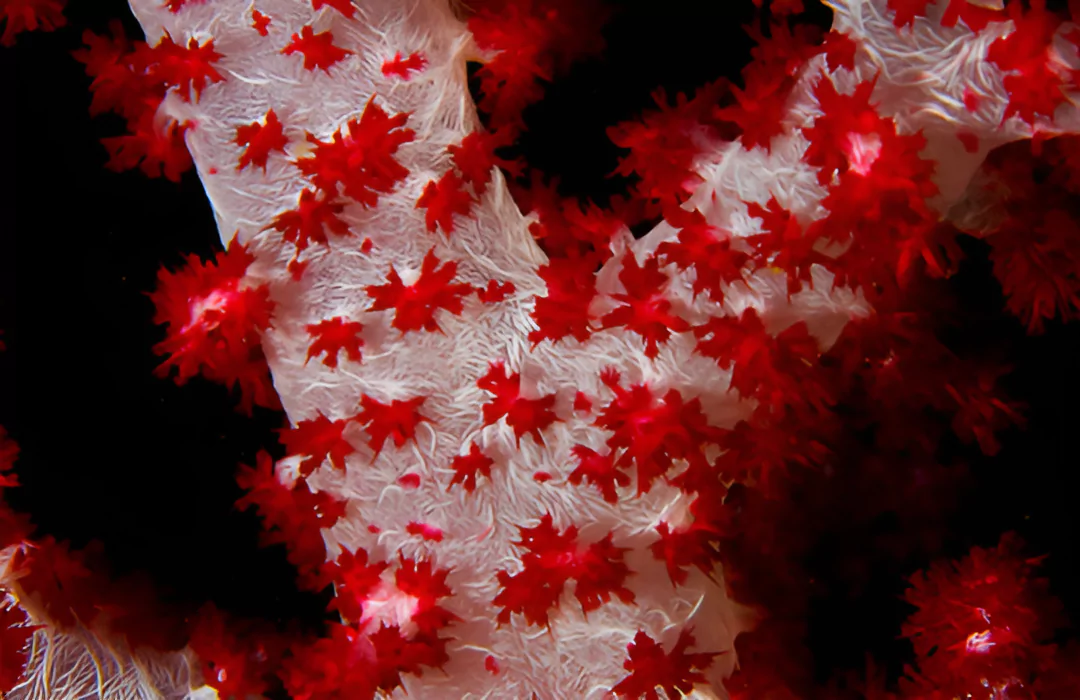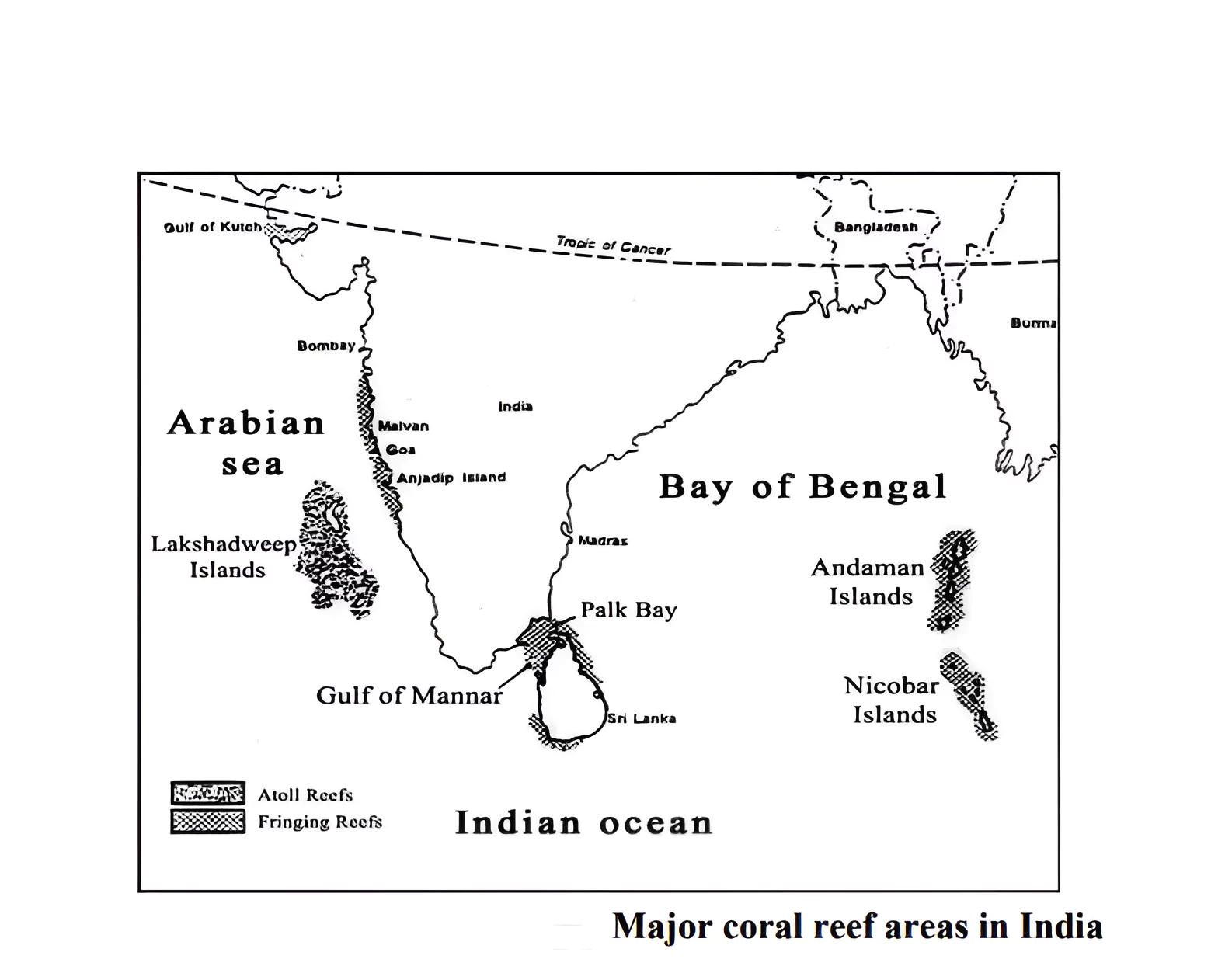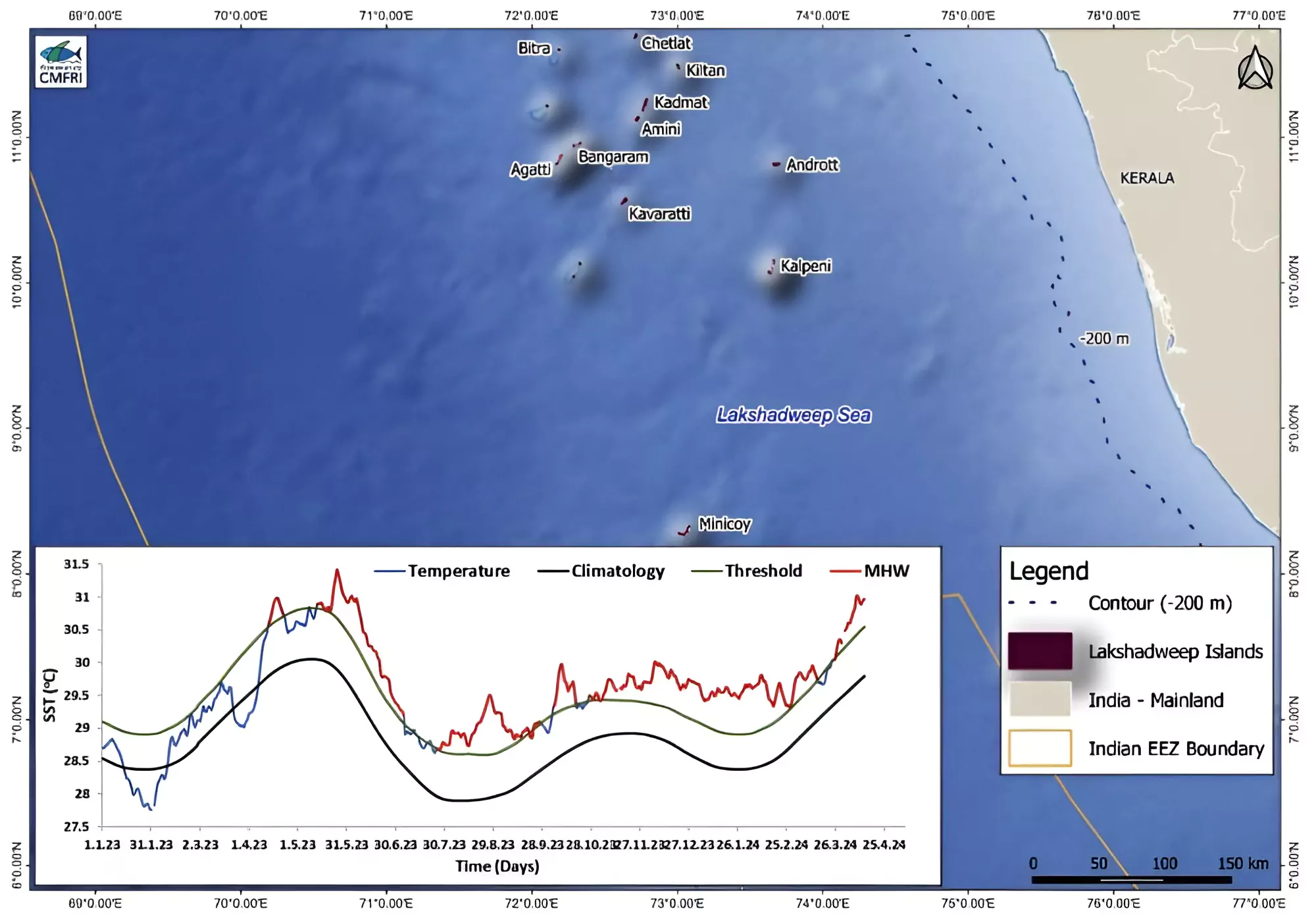Context
The ICAR-Central Marine Fisheries Research Institute (CMFRI) found that coral reefs in the Lakshadweep Sea have undergone severe bleaching due to prolonged marine heatwaves since October 2023.
- Coral bleaching is threatening Lakshwadeep’s diverse marine ecosystems.
International Coral Reef Initiative (ICRI)
About: It is a global partnership between Nations and organizations striving to preserve coral reefs and related ecosystems around the world.
Founded: It was founded in 1994 by eight governments, namely Australia, France, Japan, Jamaica, the Philippines, Sweden, the United Kingdom, and the United States of America.
It was announced at the First Conference of the Parties of the Convention on Biological Diversity in December 1994.
Membership: ICRI now counts over 100 members including India. |
Coral Reefs
Corals are sessile animals, i.e. they permanently attach themselves to the ocean floor. They are formed when thousands of polyps living together in a coral colony secrete calcium carbonate exoskeleton beneath it. Over time, the skeletons of many coral colonies add up to build the structure of a coral reef. An individual coral is known as a polyp. A polyp is a sac-like animal,excretes an exoskeleton near the base. Polyps form a symbiotic relationship with plant-like cells called zooxanthellae (unicellular dinoflagellates).
Enroll now for UPSC Online Course

- Classification: They are classified as either ‘hard’ or ‘soft’.
- Hard Corals: They have stony skeletons made of limestone that are produced by coral polyps. When polyps die, their skeletons are left behind and used as foundations for new polyps.”
- These stony coral skeletons, over thousands and millions of years, form complex coral reefs, which have often been referred to as “rainforests of the sea” — home to thousands of marine species, and vibrant ecosystems.
- Soft corals: Like sea fingers and sea whips, they are soft and bendable and often resemble plants or trees. These corals do not have stony skeletons and are non-reef-building corals.
 Instead, they grow wood-like cores and fleshy rinds for protection. Like hard corals, they tend to live in colonies.
Instead, they grow wood-like cores and fleshy rinds for protection. Like hard corals, they tend to live in colonies.- Almost all of Lakshadweep’s islands are coral atolls, with their soil largely derived from corals, and extant coral reefs around them.
- Distribution: They are found mostly in tropical and subtropical waters occurring between 30º north and 30º south latitudes.
- Types of Coral Reefs:
- Fringing reef (Shore reefs): It is a coral platform attached to a continental coast or an island, sometimes separated by a narrow, shallow lagoon known as Boat Channel.
- Barrier reef: It is roughly parallel to a shore and separated from it by a lagoon or other body of water
- Atoll Reefs: These are the reefs that are roughly circular and surround a large central lagoon.
- Conditions for Survival:
- Shallow Water: Corals require sunlight and clear shallow water for their growth. They are found typically in water above 165 feet (50 meters).
- Clear Water: This lets sunlight pass through. They don’t thrive well when the water is opaque.
- Warm Water: Reef-building corals require warm water conditions to survive. Different corals living in different regions can withstand water temperatures in the range of 20–32° C.
- Pollution-free water: Corals are sensitive to pollution and sediments. Wastewater discharged into the ocean near the reef can contain too many nutrients that cause seaweeds to overgrow the reef
- Salinity: Corals need saltwater (salinity almost 27 ppt) to survive and require a certain balance in the ratio of salt to water.
 Thus, corals don’t live in areas where rivers drain fresh water into the ocean ie. estuaries.
Thus, corals don’t live in areas where rivers drain fresh water into the ocean ie. estuaries.
- Some Endemic Coral Species In India: C. clavus Scacchi, C. arcuata M. Edwards & Haime, P. andamanensis.
Coral Bleaching
Coral bleaching occurs when the coral Polyp expels the marine algae ie. zooxanthellae from its tissue and breaks the symbiotic relation. This result in them losing their color and source of nutrients and energy with coral’s bright white skeleton is revealed.Bleached corals are not dead, but run the risk of starvation and disease. According to experts, without their algae, corals can survive for about two weeks.
- Reasons: Coral bleaching takes place when the water is too warm. In such conditions, corals expel the microscopic algae which live in their tissues, and, in simple terms, produce food for them.
- Corals experience thermal stress when sea surface temperatures exceed 1 degree celsius above the maximum mean temperature. This stress worsens if the high temperatures persist over a period of time.

Reasons for Coral Bleaching in Lakshadweep
- Rise in temperature: Degree Heating Week (DHW) in Lakshadweep crossed this threshold wherein Lakshadweep Sea has been consistently experiencing temperatures 1 degree celsius above the norm since October 27, 2023.
- Apart from excessive atmospheric heat (caused due to Global Warming), shifts in ocean currents also lead to unusually high water temperatures.
- Marine Heat Waves: Lakshadweep has been gripped by marine heat waves since October 2023. If the water does not cool down, the bleaching can eventually lead to the death of Lakshwadeep’s corals.
- Lakshadweep Sea has previously seen coral bleaching events in 1998, 2010 and 2015, but the scale of the current one is unprecedented.
Marine Heat Waves Across Indian Ocean
- Rise in Marine Heat Waves: As per 2022 study by Indian Institute of Tropical Meteorology (IITM) Pune, marine heatwaves are increasing in the Indian Ocean.
| Marine Heatwave: It is a period of unusually high ocean temperatures and is defined by its duration and intensity.
It occurs when the surface temperature of a particular region of the sea rises to 3 or 4 degree Celsius above the average temperature for at least five days.
Degree Heating Week (DHW) Indicator:
- About: It is used to measure accumulated heat stress in an area over the past 12 weeks, by adding up any temperature that exceeds the bleaching threshold during that time period.
- This is calculated in celsius-weeks.
- DHW values above 4 degrees Celsius-weeks cause significant coral bleaching.
|
-
- The study reported a significant increase in marine heatwaves, due to the rapid warming in the Indian Ocean and strong El Niños.
- Rate of Increase Across Indian Ocean Regions: The western Indian Ocean region experienced the largest increase in marine heatwaves at a rate of about 1.5 events per decade, followed by the north Bay of Bengal at a rate of 0.5 events per decade.
- During 1982–2018, the western Indian Ocean had a total of 66 events while the Bay of Bengal had 94 events.
- An underwater survey showed that 85% of the corals in the Gulf of Mannar near the Tamil Nadu coast got bleached after the marine heatwave in May 2020.
Enroll now for UPSC Online Classes
Impact of Marine Heatwaves:
- Impacts on Coastal Communities: The heat waves threaten livelihoods of coastal communities, tourism and fisheries sectors, and critical marine habitats, including seagrass meadows.
- Marine Ecosystems: Similar to corals, seagrass meadows, kelp forests are experiencing detrimental impacts such as impaired photosynthesis, reduced growth, and hindered reproductive functions due to the heatwaves.
- Impact on Coral Reefs: Lakshadweep is formed by coral reefs and hence the health of reefs are important for the very structure of the islands.
- Death of coral may also lead to accumulation of organic matter, preventing the formation of corals later.
Also Read: The Fourth Global Coral Bleaching Event Is Underway
![]() 7 May 2024
7 May 2024

 Instead, they grow wood-like cores and fleshy rinds for protection. Like hard corals, they tend to live in colonies.
Instead, they grow wood-like cores and fleshy rinds for protection. Like hard corals, they tend to live in colonies. Thus, corals don’t live in areas where rivers drain fresh water into the ocean ie. estuaries.
Thus, corals don’t live in areas where rivers drain fresh water into the ocean ie. estuaries.